Intro
Learn about Hand Foot And Mouth Virus symptoms, including rash, fever, and mouth sores, and discover its causes, treatment, and prevention methods to protect against this contagious viral infection.
The hand, foot, and mouth disease, commonly referred to as HFMD, is a viral infection that primarily affects infants and children under the age of five, but it can also occur in adults. This illness is highly contagious and spreads quickly through direct contact with an infected person's respiratory secretions, such as mucus and saliva, or through contact with contaminated surfaces. Understanding the symptoms of HFMD is crucial for early detection, treatment, and prevention of its spread.
The hand, foot, and mouth disease is characterized by its distinctive symptoms, which include sores in the mouth and a rash on the hands and feet. The onset of the disease typically begins with a fever, which can range from mild to high, followed by the development of painful sores in the mouth, including the tongue, gums, and the roof of the mouth. These sores can make eating and drinking painful, leading to dehydration if not properly managed. Additionally, a rash may appear on the hands and feet, which can be flat or raised and may blister.
The disease is usually caused by coxsackieviruses A and B, and enterovirus 71, which are part of the picornavirus family. These viruses are highly contagious and can spread through various means, including direct contact with an infected person, contaminated food and water, and contact with contaminated surfaces. Good hygiene practices, such as frequent handwashing and proper cleaning of surfaces, are essential in preventing the spread of the disease.
Understanding Hand Foot And Mouth Virus Symptoms
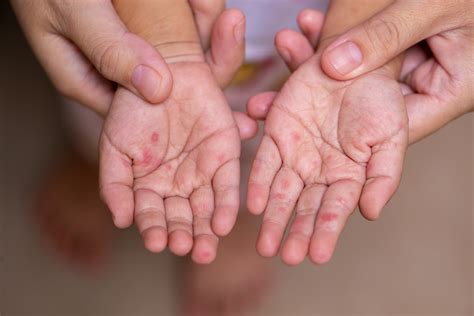
Recognizing the symptoms of HFMD is vital for seeking appropriate medical care. The symptoms can vary from person to person but typically include a fever, which can be the first sign of the illness, followed by the development of sores in the mouth and a rash on the hands and feet. The sores in the mouth can be painful and may make eating and drinking difficult, while the rash on the hands and feet can be itchy and uncomfortable. Other symptoms may include irritability, loss of appetite, and a general feeling of being unwell.
Common Symptoms Of Hand Foot And Mouth Disease
The common symptoms of HFMD include: - Fever - Sores in the mouth - Rash on the hands and feet - Irritability - Loss of appetite - General feeling of being unwellCauses And Risk Factors Of Hand Foot And Mouth Disease
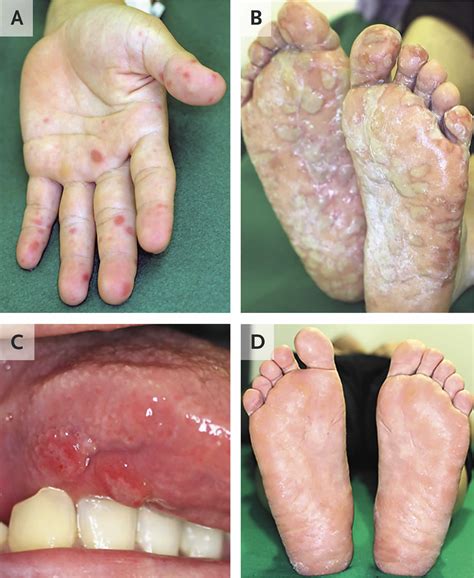
The causes of HFMD are primarily viral infections, with coxsackieviruses A and B, and enterovirus 71 being the most common causative agents. These viruses are highly contagious and can spread through direct contact with an infected person's respiratory secretions, such as mucus and saliva, or through contact with contaminated surfaces. Risk factors for developing HFMD include age, with children under the age of five being most susceptible, poor hygiene, and a weakened immune system.
Prevention And Treatment Of Hand Foot And Mouth Disease
Prevention and treatment of HFMD are crucial in managing the disease and preventing its spread. Prevention measures include practicing good hygiene, such as frequent handwashing, proper cleaning of surfaces, and avoiding close contact with individuals who are infected. Treatment for HFMD is typically focused on relieving symptoms, such as reducing fever and pain, and preventing dehydration. In severe cases, hospitalization may be necessary to manage complications and prevent further spread of the disease.Complications Of Hand Foot And Mouth Disease
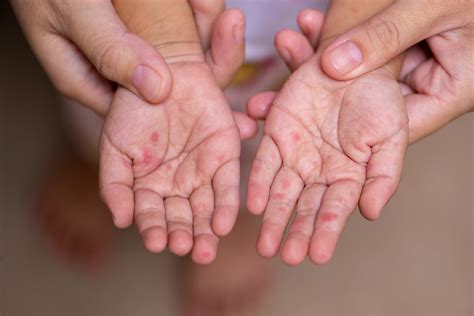
Complications of HFMD can occur, especially in severe cases or if the disease is not properly managed. These complications can include dehydration, which can be severe if not promptly treated, and the spread of the virus to other parts of the body, such as the brain, heart, or lungs, leading to more serious conditions like meningitis, encephalitis, or pneumonia. Additionally, HFMD can lead to secondary bacterial infections, which may require antibiotic treatment.
Diagnosis And Management Of Hand Foot And Mouth Disease
Diagnosis of HFMD is typically based on clinical presentation, including the characteristic symptoms of fever, sores in the mouth, and a rash on the hands and feet. Laboratory tests, such as viral PCR or serology, may be conducted to confirm the diagnosis and identify the causative virus. Management of HFMD includes symptomatic relief, such as reducing fever and pain, and preventing dehydration. In some cases, antiviral medications may be prescribed to help manage the disease.Home Remedies For Hand Foot And Mouth Disease

Several home remedies can help alleviate the symptoms of HFMD, including:
- Offering cool fluids to help with hydration and soothe the throat
- Providing pain relief through over-the-counter medications
- Using topical creams or gels to soothe the rash
- Encouraging rest to help the body recover
Preventing The Spread Of Hand Foot And Mouth Disease
Preventing the spread of HFMD is crucial, especially in settings like schools and daycare centers where the disease can spread quickly. Prevention measures include practicing good hygiene, such as frequent handwashing, covering the mouth and nose when coughing or sneezing, and avoiding close contact with individuals who are infected. Proper cleaning and disinfection of surfaces and objects that may be contaminated with the virus can also help prevent the spread of the disease.Hand Foot And Mouth Disease In Adults
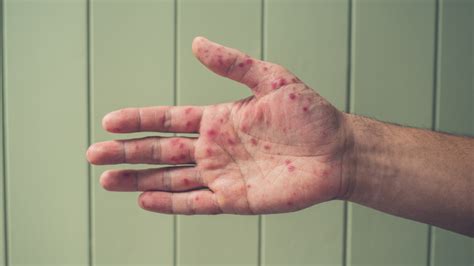
While HFMD is more common in children, adults can also contract the disease. Adults who are at higher risk of developing HFMD include those with weakened immune systems, such as individuals with chronic illnesses or taking immunosuppressive medications. Symptoms in adults can be similar to those in children but may also include more severe complications, such as myocarditis or pneumonia. Prevention and treatment strategies for adults are similar to those for children, emphasizing good hygiene practices and symptomatic relief.
Long-Term Effects Of Hand Foot And Mouth Disease
The long-term effects of HFMD are generally minimal, with most individuals recovering fully within a few days to a week without any lasting complications. However, in severe cases or if the disease is not properly managed, long-term effects can include neurological complications, such as seizures or cognitive impairments, and cardiac issues. It is essential to seek medical attention if symptoms persist or worsen over time.Current Research On Hand Foot And Mouth Disease
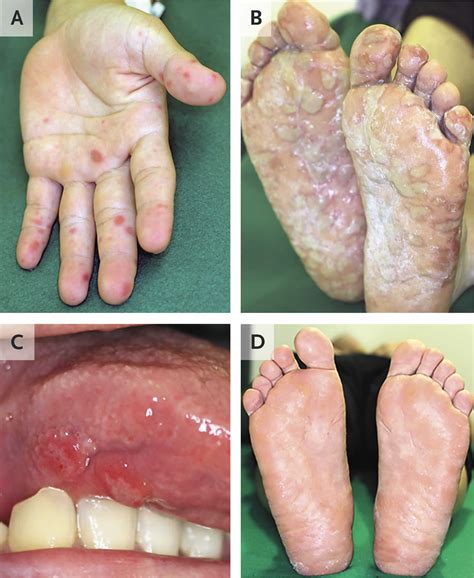
Current research on HFMD is focused on understanding the viral mechanisms, developing effective vaccines, and improving treatment options. Researchers are also exploring the potential for antiviral medications to treat HFMD and reduce the risk of complications. Furthermore, studies are being conducted to better understand the epidemiology of the disease and to develop more effective prevention strategies.
Global Impact Of Hand Foot And Mouth Disease
The global impact of HFMD is significant, with outbreaks occurring worldwide, particularly in Asia. The disease can have a substantial economic impact, especially in areas with limited healthcare resources, due to the costs associated with medical care and the loss of productivity. International collaboration and the sharing of research findings are crucial in managing the global spread of HFMD and in developing effective prevention and treatment strategies.Conclusion And Final Thoughts

In conclusion, hand, foot, and mouth disease is a common viral illness that affects individuals of all ages but is most prevalent in children under the age of five. Understanding the symptoms, causes, and risk factors of HFMD, as well as the prevention and treatment options available, is essential for managing the disease and preventing its spread. By practicing good hygiene, seeking medical attention when necessary, and staying informed about the latest research and developments, we can work towards reducing the incidence and impact of HFMD globally.
We invite you to share your experiences or ask questions about hand, foot, and mouth disease in the comments section below. Your input can help others understand the disease better and foster a community of support and awareness. Additionally, consider sharing this article with friends and family to help spread awareness about HFMD and its importance in public health.
What are the common symptoms of hand, foot, and mouth disease?
+The common symptoms include fever, sores in the mouth, a rash on the hands and feet, irritability, loss of appetite, and a general feeling of being unwell.
How is hand, foot, and mouth disease spread?
+The disease is spread through direct contact with an infected person's respiratory secretions, such as mucus and saliva, or through contact with contaminated surfaces.
Can adults get hand, foot, and mouth disease?
+Yes, adults can get hand, foot, and mouth disease, especially those with weakened immune systems. However, it is less common in adults than in children.
How can hand, foot, and mouth disease be prevented?
+Prevention measures include practicing good hygiene, such as frequent handwashing, avoiding close contact with infected individuals, and properly cleaning and disinfecting surfaces and objects.
Is there a vaccine for hand, foot, and mouth disease?
+Currently, there is no widely available vaccine for hand, foot, and mouth disease, but researchers are working on developing effective vaccines to prevent the disease.
